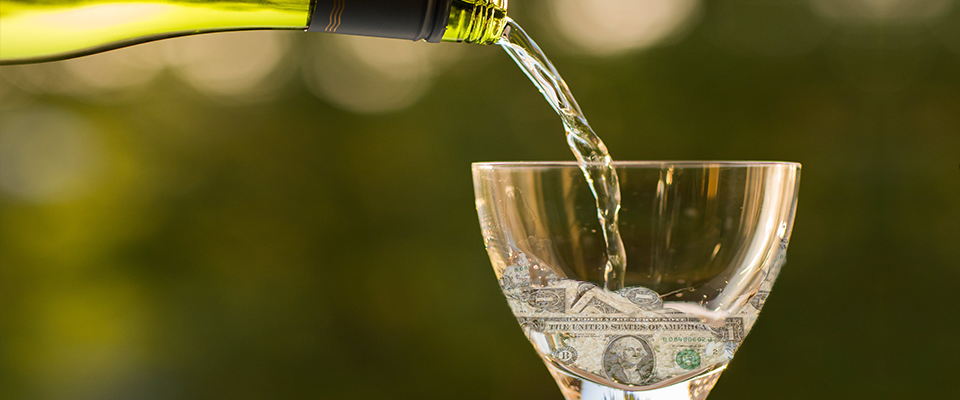Thirty years ago, the most-prized wines in California—including Robert Mondavi Reserve Cabernet, Duckhorn Three Palms Merlot, Heitz Martha’s Vineyard Cabernet—sold for under $30. Opus One got attention with its shocking price of $50. Inflation since then has roughly doubled the value of money. But the cheapest of those famous wines now costs about four times as much. Heitz Martha’s Vineyard is now $200; Opus One is $225.
And they’re not even considered expensive anymore. Napa has dozens of wines priced more than Opus One, and several over $500. Screaming Eagle retails for a whopping $1800, about 30 times what the most expensive Napa wine cost 26 years ago.
So why are people willing to pay so much more for California wine now?
It’s not because we have that much more money to spend. It would be convenient to associate expensive wine purchases with the increasing wealth of the very rich, but Berkeley economist Martha Olney says that’s a mistake. “There’s always been rich people,” says Olney, an adjunct professor of economics at Berkeley who studies consumer spending and indebtedness. “But there hasn’t always been lots of demand for $125 bottles of Cabernet.”
And it’s not because wine costs that much more to make. Sure, some wines, like Harlan Estate ($800), are made more painstakingly than ever, with each grape individually considered for inclusion or rejection. On average, wines in California cost less than $35 per bottle to produce, according to a 2006 study by the independent market research firm MKF Research.
To get at the answer, you have to look at the psychology of consumption.
Robin Goldstein does just that. When he was a visiting scholar in Berkeley’s economics department, he conducted a series of experiments that suggest people are spending more money on wine than they need to. “One of the projects I’ve been working on for years is a series of blind tastings where people taste wines going up from a couple dollars to hundreds of dollars,” Goldstein says. “Consumers slightly prefer cheaper styles of wine when they don’t know what they’re drinking.”
So why pay more?
One reason is familiar to many people with neighbors who own fancy cars: “A lot of people want to take their wife out to dinner. They want to order a bottle of Champagne and they want other people to see the bottle,” says Paul Lukacs, director of the center for humanities at Loyola University Maryland and author of several books on wine history. “Wine is an adjunct. People can see it the same way they can see your clothes.”
Lukacs says that obsession with specific expensive wines is, perhaps counter-intuitively, a middle-class hobby. “It’s the middle class who becomes obsessed with, ‘I want bottle X vs bottle Y,’” Lukacs says. “The aristocrats say, ‘We’ve been drinking Château Latour for six generations.’”
Seen in that light, a $300 bottle of wine is a more affordable status marker than a sports car or designer handbag.
Moreover, Goldstein says it’s not even important for other people to see the wine. “Social signaling is the classic conspicuous consumption, showing off how knowledgeable you are to other people. Self-signaling is, ‘I’m drinking an expensive wine because I like to think of myself as that kind of guy. I like that to be my identity.’ You can sit down with the bottle of wine by yourself. It’s not to show off to anyone else, it’s to show off to yourself. But it really changes the experience of the wine.”
Goldstein says neurological research shows that “people’s pleasure centers light up more when they have knowledge of how expensive a wine is.”
In one of Goldstein’s experiments, he offers people two glasses of wine, one from a bottle that he says costs $50, and the other $5. In reality, the wine is the same. Most people prefer the wine they believe is more expensive. “Their imagination takes over and they often vastly prefer one wine to another,” Goldstein says.
Less than a nation of connoisseurs, Goldstein’s research seems to indicate that we’ve become a nation of snobs.
“One of the things I’ve found in my preliminary research is that people are more negatively sensitive to the knowledge that a wine is cheap than they are positively sensitive to the knowledge that a wine is expensive,” Goldstein says. “If I serve you a wine and tell you that it costs $4, you’ll have a much more negative experience of the wine. It really biases you against the wine even more strongly than it biases you towards the wine when you know it costs $100.”
Goldstein sees the strength of the self-signaling effect during his debriefing of the subjects. In another experiment, he gives people a glass of Dom Pérignon Champagne ($145 a bottle) and a glass of Domaine St. Michelle sparkling wine ($12 a bottle) without identifying them.
“Every time we’ve done this, a majority of people strongly prefer the Domaine Ste. Michelle,” Goldstein says. “And then they’re always really upset when we reveal the bottle. They say the Dom Perignon must be corked. The first reaction is to become defensive, to say, ‘I am the kind of person who can appreciate the taste, and that there must have been something wrong with the bottles.’”
People pay a lot of money to psychiatrists to try to feel better about themselves. In that light, perhaps we can best understand the rise of high-end wine prices as a fast new form of self-image therapy.



















